
FDA Approves Combination of Brentuximab Vedotin and Chemotherapy for Frontline Use in Hodgkin Lymphoma
The FDA has approved brentuximab vedotin (Adcetris) for use as a frontline treatment, in combination with chemotherapy, for adult patients with stage III or IV classical Hodgkin lymphoma.
The FDA has approved brentuximab vedotin (Adcetris) for use as a frontline treatment, in combination with chemotherapy, for adult patients with stage III or IV classical Hodgkin lymphoma.
The approval is based on findings from the phase III ECHELON-1 trial, which demonstrated superior progression-free survival (PFS) with brentuximab vedotin plus Adriamycin, vinblastine, and dacarbazine (AVD) compared with standard ABVD (AVD plus bleomycin), according to a statement from Seattle Genetics, the manufacturer of the CD30-targeted antibody-drug conjugate.
In the study, the brentuximab vedotin regimen reduced the risk of progression, death, or initiation of new therapy by 23% compared with ABVD. The 2-year modified PFS rate was 82.1% with brentuximab vedotin compared with 77.25% for standard chemotherapy (HR, 0.77; 95% CI, 0.60-0.98; P = .035).
The approval, which follows a breakthrough therapy designation the FDA granted frontline brentuximab vedotin in October 2017 for use in this setting, also converts the accelerated approval the FDA previously granted the drug for adults with systemic anaplastic large cell lymphoma after failure of at least one multiagent chemotherapy regimen to a regular approval.
“The standard of care for treating newly diagnosed advanced Hodgkin lymphoma has not changed in more than four decades. For years, the physician community has been conducting clinical trials to identify improved regimens that are both less toxic and more effective to no avail,” Joseph M. Connors, MD, FRCPC, clinical director, Center for Lymphoid Cancer at BC Cancer in Vancouver, Canada, said in a statement.
“The ECHELON-1 study results demonstrated superior efficacy of the Adcetris plus chemotherapy regimen when compared to the standard of care while removing bleomycin, an agent that can cause unpredictable and sometimes fatal lung toxicity, completely from the regimen. This represents a meaningful advance for this often younger patient population,” added Connors.
The phase III ECHELON-1 trial enrolled 1334 patients with stage III/IV classical Hodgkin lymphoma. All patients had not received prior treatment with systemic chemotherapy or radiotherapy and had an ECOG performance status of ≤2. Patients ranged in age from 18 to 83, the median age was 36 years, and 58% were men.
In both arms, treatment was given on days 1 and 15 of a 28-day cycle. Doxorubicin was given at 25 mg/m2, vinblastine was administered at 6 mg/m2, and patients received dacarbazine at 375 mg/m2. In the investigational arm, brentuximab vedotin was administered at 1.2 mg/kg and in the control group bleomycin was administered at 10 units/m2.
The primary endpoint of the study was modified PFS by independent review committee. Under the modified criteria, PFS was defined as time to progression, death, or receipt of additional therapy for those not in complete response (CR). The modified endpoint was meant to eliminate the potential impact of consolidation treatment with chemotherapy or radiotherapy. Secondary endpoints included overall survival and safety.
PFS was met with 117 events in the brentuximab vedotin arm and 146 events in the AVBD arm. At a median follow-up of 24.9 months, the 2‑year modified PFS was 82.1% (95% CI, 78.7-85.0) with the brentuximab vedotin regimen compared with 77.2% (95% CI, 73.7-80.4) with ABVD.
The CR rate was 73% for the brentuximab vedotin arm and 70% for the ABVD arm. In addition, researchers found that 33% fewer patients treated with the brentuximab vedotin regimen received subsequent chemotherapy or high-dose chemotherapy and transplant compared with the patients treated with ABVD.
Safety profiles were consistent with known toxicities of the single agents. Grade ≥3 infections were more common in the brentuximab vedotin group (18%) than the ABVD arm (10%).
Neutropenia was reported in 58% of patients who received the brentuximab vedotin regimen compared with 45% who received ABVD. In the brentuximab vedotin arm, the rate of febrile neutropenia was lower among the 83 patients who received primary prophylaxis with GCSF than among those who did not (11% vs 21%).
Peripheral neuropathy occurred in 67% of patients receiving brentuximab vedotin plus AVD and 43% of patients receiving ABVD.
There were 28 deaths in the brentuximab vedotin cohort and 39 in the ABVD arm (HR for interim overall survival, 0.72; 95% CI, 0.44-1.17; P = 0.19). Among the deaths that occurred during treatment, 7 of 9 in the brentuximab vedotin group were associated with neutropenia and 11 of 13 in the ABVD group were associated with pulmonary-related toxicity.
Brentuximab vedotin is currently approved for patients with classical Hodgkin lymphoma following autologous hematopoietic stem cell transplantation (HSCT) or after failure of 2 prior regimens, if not candidates for HSCT. The agent is also approved as consolidation therapy for patients with Hodgkin lymphoma at high risk of relapse or progression following autologous HSCT.
Reference
Connors J, Jurczak W, Straus D J., et al. Brentuximab vedotin plus doxorubicin, vinblastine, dacarbazine (A+AVD) as frontline therapy demonstrates superior modified progression-free survival versus ABVD in patients with previously untreated stage III or IV hodgkin lymphoma (HL): the phase 3 echelon-1 study. Presented at: ASH Annual Meeting and Exposition; Dec. 9-12, 2017; Atlanta. Abstract 6.
Newsletter
Knowledge is power. Don’t miss the most recent breakthroughs in cancer care.


















































































